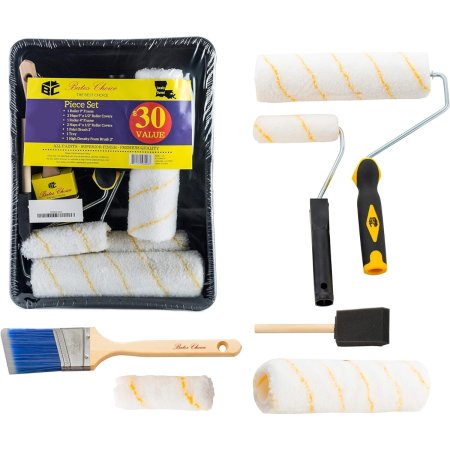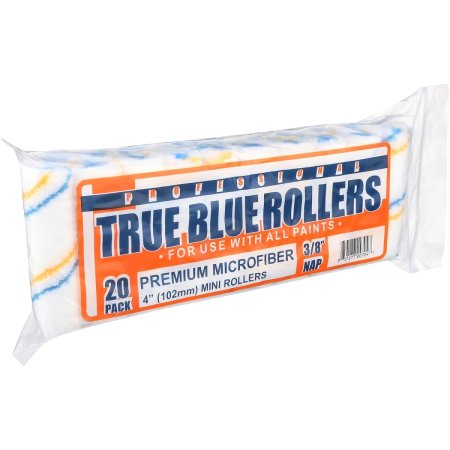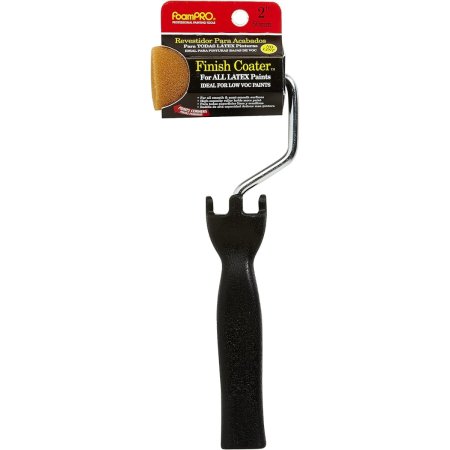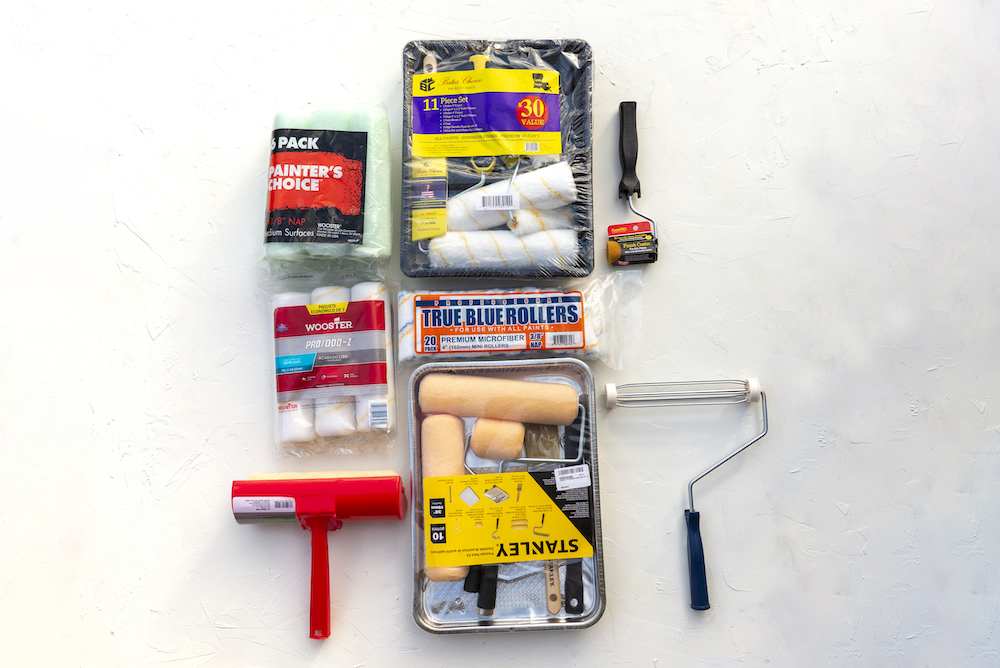
We may earn revenue from the products available on this page and participate in affiliate programs. Learn More ›
There are many do-it-yourself projects that allow for scrimping on costs without any negative effects on your results—painting, however, is not one of them (especially the paint roller). For a professional-looking paint job, you need to start with quality tools.
You’ll likely reach for a paintbrush when cutting in or painting trim, but covering the bulk of the wall or ceiling with paint becomes a speedier and much simpler job when you use a paint roller. Not only that, but the right roller-and-cover combination works to spread paint smoothly and evenly so you aren’t left with brushstrokes, patchy spots, or other imperfections.
Paint rollers and covers are simple and generally quite affordable tools, but there are many options to choose from. We tested the top roller covers and frames on the market. The Wooster Pro/Doo-Z Woven Roller Cover came out on top for its professional-level finish and microfiber material that left the smoothest finish of all the 9-inch rollers we tested. Our guide explains what to consider and what to look for, and it offers details on our favorite picks among the best paint roller-and-cover options available.
- BEST OVERALL: Wooster Pro/Doo-Z Woven Roller Cover
↓ Jump to Review - BEST BANG FOR THE BUCK: Bates Choice 11-Piece Home Painting Supplies
↓ Jump to Review - BEST FOR SMALL PROJECTS: True Blue Professional Microfiber Mini Rollers
↓ Jump to Review - BEST FOR TRIM: FoamPro 2-Inch Finish Coater Mini Roller
↓ Jump to Review - BEST FOR CEILINGS: Shur-Line 9-Inch Roller Cover With Shield
↓ Jump to Review - BEST FOR TEXTURED SURFACE: Wooster Painter’s Choice 6-Pack Roller Covers
↓ Jump to Review - ALSO CONSIDER: Wooster 9-Inch Utility Frame
↓ Jump to Review
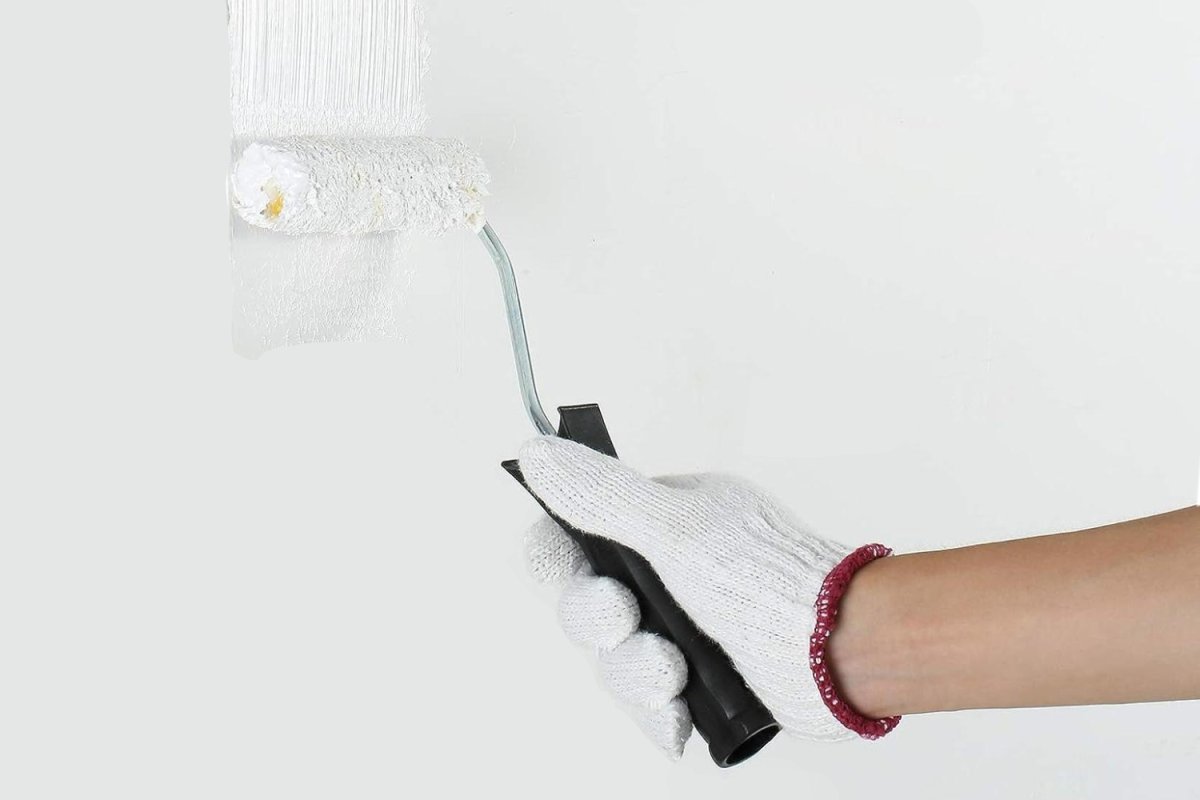
How We Tested the Best Paint Rollers
We tested the paint roller covers according to an established rubric, including material type, size, and coverage criteria. We rated the rollers on a scale of 0 to 5 to determine their score.
We used each roller with flat and semi-gloss paint and applied it to the surfaces recommended by the manufacturer. Once each coat of paint was applied, we examined the coverage. Next, we looked at the surface to see if the roller left behind any lint. Also, if applicable, we evaluated the ergonomics of the roller frames and determined how smoothly they rolled. Finally, how well the roller’s core held up with cleaning was taken into consideration during testing as a bonus feature, but we felt that should not affect the roller’s overall painting performance.
| Testing Stats | |
| Products tested | 8 |
| Time spent testing | 8 hours |
| Tests performed | 3 to 4 |
| Price range | $5 to $20 |
Our Top Picks
With those key features and shopping tips in mind, we’ve spent hours narrowing the market to its top-rated products. We put the top picks through serious testing, and any of these recommendations for the best paint rollers should suit your needs.
Best Overall
Wooster Pro/Doo-Z Woven Roller Cover
Product Specs
- Material: Doo-Z/microfiber
- Size: 9 inches
- Surfaces: Semi-smooth
Our Ratings: Ease of Use 5/5;Performance 5/5; Value 5/5
What We Like
- Does not shed
- Resists matting
- Holds a good amount of paint
What We Don’t Like
- Can get expensive if you need multiple packs
Wooster is a well-known paint tool brand for DIYers and professionals alike. Its Pro/Doo-Z roller features a proprietary fiber called Doo-Z, which is made from interlocked, dense fibers similar to microfiber that resist shedding, dripping, and spatter. These rollers are perfect for use with all paints, enamels, and varnishes in sheens from flat to gloss.
In testing, the Pro/Doo-Z roller cover produced the smoothest finish of all the rollers tested. The rollers used in our test are designed for use on semi-smooth surfaces. However, even when we rolled it onto a smooth wood surface, it produced a smooth, lint-free finish. The downside to this roller cover is that it was the most expensive roller cover we tested. However, its dense fabric holds up to cleaning, so if you want to reuse it, you can!
Get the Wooster Pro/Doo-Z paint roller at Ace Hardware or The Home Depot.
Best Bang For The Buck
Bates Choice 11-Piece Home Painting Supplies
Product Specs
- Material: Microfiber
- Size: 9 inches and 4 inches
- Surfaces: Smooth and semi-smooth
Our Ratings: Ease of Use 4/5;Performance 4.7/5; Value 4.3/5
What We Like
- All-in-one painting kit
- Includes 2 covers for each frame size
- Inexpensive for a comprehensive set
What We Don’t Like
- Hard to remove roller cover from frame
The Bates 11-piece set includes various paint tools to complete most home and crafting projects. The kit features a 9-inch roller frame with two covers, a 4-inch roller frame with two covers, a 2.5-inch angled sash brush, one 2-inch high-density foam paintbrush, a metal paint tray, a paint can opener, and a wooden paint stirrer.
We liked all the extra tools included in this set, especially the paint stirrer and paint can opener. In testing, we found that the roller frames rotate smoothly, which made it easier to apply an even, smooth coat of paint. The large paint rollers have a ½-inch nap, meaning they’re designed to pick up a lot of paint, so they’re better suited for textured surfaces like wood paneling, painted brick, or concrete. We found that the only major drawback was that the roller cover was tough to remove from the frame after painting. However, this kit is a fantastic deal for all the tools and the quality of the roller covers.
Get the Bates Choice paint roller at Amazon or Walmart.
Best For Small Projects
True Blue Professional Microfiber Mini Rollers
Product Specs
- Material: Microfiber
- Size: 4 inches
- Surfaces: Semi-smooth
Our Ratings: Ease of Use 5/5;Performance 4.3/5; Value 4.5/5
What We Like
- Usable with a variety of paint, epoxies, and varnishes
- Doesn’t shed
- Easy to wash and reuse
What We Don’t Like
- Drip prone
This pack of 20 roller covers would be great to keep on hand for tackling small paint projects around the house such as touching up walls, painting baseboards or trim, or smoothing stain over furniture. The True Blue 4-inch roller covers are microfiber and have a ⅜-inch nap, which is well suited for most lightly textured surfaces. The rollers apply paint smoothly, without leaving behind any annoying lint or fibers. Match the roller covers to your favorite 4-inch roller frame.
We like that this roller is suitable for epoxies, latex paints/stains, and oil-based products. Overall, True Blue’s professional roller covers worked very well on lightly textured and smooth surfaces. The microfiber covers left no lint behind on the surface. However, microfiber holds a lot of paint, so there is the danger of drips after loading. We had to run the roller over the ridges on the paint tray several times to redistribute the paint on the roller.
Get the True Blue paint roller at Amazon.
Best For Trim
FoamPro 2-Inch Finish Coater Mini Roller
Product Specs
- Material: Foam
- Size: 2 inches
- Surfaces: Soooth and semi-smooth
Our Ratings: Ease of Use 4/5;Performance 4/5; Value 4/5
What We Like
- Leaves a smooth finish
- Leaves no lint
- Fits in tight corners
What We Don’t Like
- Not suited for textured surfaces
The FoamPro Finish 2-inch roller is made of high-density foam that leaves a beautifully smooth finish. Because of its size, the foam roller is ideal for painting fence posts, furniture, or other small, oddly shaped items. The little roller is also perfect for painting trim, moldings, door frames, or tight corners.
In testing, we found that the roller glides very easily over any type of smooth or semi-smooth surface, including drywall, wood, and metal. However, it did not perform well on any surface with the slightest texture. It is a finishing roller, and it does a great job providing a smooth, final finish. It’s a good foam roller to have on hand for DIY painting projects.
Get the FoamPro paint roller at Amazon or The Home Depot.
Best For Ceilings
Shur-Line 9-Inch Roller Cover With Shield
Product Specs
- Material: Polyester
- Size: 9 inches
- Surfaces: Semi-smooth to textured
Our Ratings: Ease of Use 5/5;Performance 4.7/5; Value 4/5
What We Like
- Limits paint spray
- Reusable paint cover
- Rolls smoothly
What We Don’t Like
- Doesn’t paint close to edges
One of the drawbacks of painting a ceiling is the unavoidable paint spray. The Shur-Line roller and shield is a 9-inch roller with a plastic shield that wraps around the back of the roller cover. This design allows you to load the roller with paint, and it catches any paint spray that flies off the roller while you work. The tool comes with an ⅜-inch nap roller and features a threaded handle for use on an extension rod.
In testing, we found that loading the roller was easy, and it did reduce paint splatter. There are two red end caps that are removable to allow you to use them on a new roller cover. Removing the roller was not tricky, but inserting it did take some effort. Although the roller frame does not have ball bearings, it did roll smoothly. The only drawback is that the shield does not allow you to paint close to edges.
Get the Shur-Line ceiling paint roller at Amazon or Walmart.
Best For Textured Surface
Wooster Painter’s Choice 6-Pack Roller Covers
Product Specs
- Material: Polyester
- Size: 9 inches
- Surfaces: Textured
Our Ratings: Ease of Use 4/5;Performance 4.3/5; Value 4/5
What We Like
- Inexpensive yet effective option
- Covers textured surfaces well
- Multipack is great for lots of paint project
What We Don’t Like
- Leaves some lint
Textured surfaces require a long nap to apply paint in all the nooks and crannies. The Wooster Brush Painter’s Choice roller cover features a ⅜-inch nap and is designed to apply flat and eggshell paint on textured surfaces. The economically priced pack features six roller covers.
In testing, we found that the roller covers performed as intended. These rollers are only for use on textured surfaces, but we did test them on smooth surfaces to see if they could possibly be multiuse. However, the Painter’s Choice Roller cover did not leave a smooth finish whatsoever. The rollers also leave a little bit of lint. This roller is best for masonry or ceilings.
Get the Wooster Painter’s Choice paint roller at Amazon or The Home Depot.
Also Consider
Wooster 9-Inch Utility Frame
Product Specs
- Material: Fiberglass
- Size: 9 inches
- Surfaces: Depends on cover used
Our Ratings: Ease of Use 4/5;Performance 4/5; Value 4/5
What We Like
- Very inexpensive
- Rolls smoothly
- Fits most 9-inch roller covers
What We Don’t Like
- Thin frame handle is a little flimsy
A quality roller cover deserves a quality frame, and that’s just what you get with this 9-inch model. The molded grip feels good and stays secure in your hand, while the fiberglass cage has a quick-release spring that keeps your roller cover secure while you’re working, then releases it with a tap when you’re ready to clean up. Use any 9-inch cover with the frame.
Overall, the roller frame moved smoothly and easily accepted all the 9-inch roller covers we tested. Removing the rollers was easy, and we thought the handle felt very comfortable, but it was thinner than the other roller frames we tested. Overall, it’s a decent, inexpensive roller frame to have on hand for any painting project.
Get the Wooster 9-inch paint roller at Amazon or The Home Depot.
Jump to Our Top Picks
What To Consider When Choosing a Paint Roller
To many, a paint roller may seem like a standard painting tool to be quickly grabbed off the shelf at the hardware store, but there are few aspects to keep in mind when shopping to help improve your painting projects. We discuss the main features of a paint roller to look out for below.
Roller Frame
A roller frame—the skeleton of this reusable painting tool—is basically a comfortable plastic handle connected to a roller cage (the part of the frame that slips inside the roller cover). Typically, roller cages have plastic caps at either end supporting the compression metal “ribs” that fit inside a cover and hold it securely in place, but you’ll also find roller frames with sturdy plastic cages.
Roller frames are sold in sets with covers for convenience, but you have more control over the quality of your supplies when you purchase them separately. When comparing frames, look for these optional features:
- Ergonomic handle. If you expect to spend a lot of time painting, even just more than one room, it’s worth paying a little more for an ergonomic handle that is shaped to reduce strain on your wrist.
- Ball bearings. Quality roller frames use ball bearings to provide smooth rolling movement and a more perfect paint finish.
- Threaded handle. While it comes on most roller frames, do check for threads or clips at the bottom of the handle so you can attach an extension pole for tackling ceilings or the tops of walls.
Roller Length
Roller frames and covers come in several different lengths, and while most frames come in a fixed roller width, some of the large ones are adjustable in size, using small clips or prongs to secure the cover instead of a cage. You’ll need to match the lengths of your roller frame and cover if you want to do the job right.
- 9-inch rollers are the best size for the majority of projects tackled by DIYers. For starters, these paint rollers fit easily into a 5-gallon paint bucket. Plus, these are large enough to cover a good size swatch of wall in one roll yet notso long that they are difficult to control around trim and other details.
- 12-inch or longer rollers can be somewhat heavy and unwieldy and, therefore, are more often used by professionals than DIYers. If you really need to cover a stretch of wall in a hurry, however, you might want to choose one of these oversize rollers.
- 6- or 7-inch rollers are a good size for painting baseboard molding or small furnishings. These rollers are also useful for getting into corners or reaching behind the toilet to paint the wall.
- 4-inch mini rollers are great for touch-ups, small furnishings, tight spaces, or careful work around fixtures, windowsills, or other obstacles. They also come in handy for painting the insides of cabinets or bookcases.
Cover Material
Covers come in five common material options, which vary in terms of what paint they work best with, how much they hold, and the texture they create. Choose the right roller cover material based on your paint and project.
- Woolor mohair roller covers, with natural fibers, are the best choices for applying oil-based paint, but they work well with any finish and cover a variety of surfaces smoothly. Wool picks up a lot of paint and so provides excellent coverage with just one coat.
- Synthetic roller covers—including polyester, nylon, or Dacron—are the right choice for water-based latex paint because they resist matting. You can use a synthetic cover with any paint finish and on most surfaces. Though synthetics don’t pick up and hold as much paint as wool does, they are generally very durable.
- Roller covers that blend wool and polyester can be used with either type of paint and any paint finish, so they are a great choice if you often switch between oil-based and water-based products. These versatile roller covers offer the best of both worlds: They pick up a lot of paint and last a long time if cared for properly.
- Newer to the painting scene, microfiber roller covers (identifiable by the diagonal stripes on the plush cover) work with latex as well as oil-based paints with a matte, eggshell, or satin finish. These rollers provide a very smooth finish, almost as if sprayed on, and are suitable only on surfaces without much texture. However, there’s a bit of a learning curve to achieving an even finish with a microfiber roller because they pick up and release more paint than the average cover, so practice on cardboard or another throwaway surface before tackling your walls.
- Foam roller covers don’t last as long as the other options and, for that reason, are sometimes considered “single-use” covers. They are best for rolling semi-gloss or high-gloss latex paint over smooth—not heavily textured—surfaces. Use them for quick touch-ups on trim, baseboards, furniture, or other small projects.
You’ll also want to consider the core of the roller cover; a good one is made from some type of resin or plastic. Cheap rollers have cardboard cores, which don’t hold well and often come apart after just a few uses.
Naps for the Right Surface
The nap of a roller cover refers to the length of its fibers—yet another important decision to make based on the project at hand. Different naps are good for different surfaces. As a general rule, the shorter the nap, the smoother the surface you’ll use it on. Using a long nap on a smooth surface tends to create a bumpy finish, while a short nap on a rough surface will often tear apart or shed fibers into the paint.
- ¼-inch nap is best for very smooth walls, ceilings, cabinetry, and other surfaces without texture, including metal.
- ⅜-inch nap is good for lightly textured surfaces, including most interior walls.
- ½-inch nap is a good length for moderately textured walls, paneling, and painted brick or concrete.
- ¾-inch nap is best for heavily textured surfaces such as bare brick or concrete or textured interior walls like popcorn-textured ceilings.
- 1-inch nap and above is useful for painting stucco, cinder blocks, or rough brick.
FAQs
For more information on choosing the best paint roller, check out the answers below to some of the most commonly asked questions about these products.
Professional painters do not use one specific type of roller; rather, they use the correct roller for the surface they are painting. Microfiber rollers hold more paint and produce the smoothest finish, which makes them popular among professional painters.
The best roller for walls depends on the wall’s surface. For smooth, untextured walls, a roller with a ¼-inch nap is best. For lightly textured surfaces, including most interior walls, a roller with a ⅜-inch nap is good.
It depends on the roller material. Foam tends to be more of a single-use option, but most other roller materials types can be reused up to around 5 times if properly cleaned each time and stored properly.
Cleaning your paint rollers is fairly simple:
1. Remove the roller from the frame and soak it in warm soapy water for around an hour.
2. Use your hands (wear gloves) to massage out the paint from deep inside the roller. You’ll be surprised how much can stay in there.
3. Rinse out the roller with clean water until you no longer see any paint coming out.
This really depends on what you’re painting. For multiple surface types (smooth, rough or textured), you’ll likely want to use a specific roller suited for that surface. This is usually a matter of choosing the right nap size and thickness (which we explain in detail above).
Also, you’ll want to consider the areas you’re painting. You may use a large 9-inch roller to cover large areas but switch to a smaller 4-inch option for more detailed areas and tighter spaces.
If you’re still in the middle of your painting project and need to store your roller for a little while, you can wrap it in plastic wrap to stop the paint from coming into contact with the air and drying out. This is usually effective for up to 2 days.
For a more long-term storage solution, thoroughly clean and dry the roller, then wrap it in plastic. (Keep the original plastic cover it came in and use that—it’s the perfect size!)
Foam rollers are best for rolling semi-gloss or high-gloss latex paint over smooth, untextured surfaces. They’re great for quick touch-ups on trim, baseboards, furniture, or other small projects. They are not a suitable roller for painting heavily textured surfaces, however.
Meet the Tester
Debbie Wolfe is a photographer, author, and freelance writer in various niches. She has contributed hundreds of home, garden, and crafting articles and DIY tutorials for leading media outlets and retailers, including HGTV, Real Simple, Forbes Advisor, The Spruce, The Home Depot, Walmart, and Mother Earth News. She is the author of two DIY books: Do-It-Yourself Garden Projects and Crafts and Crafting with Herbs from Skyhorse Publishing. Her testing approach is straightforward and budget-minded.




